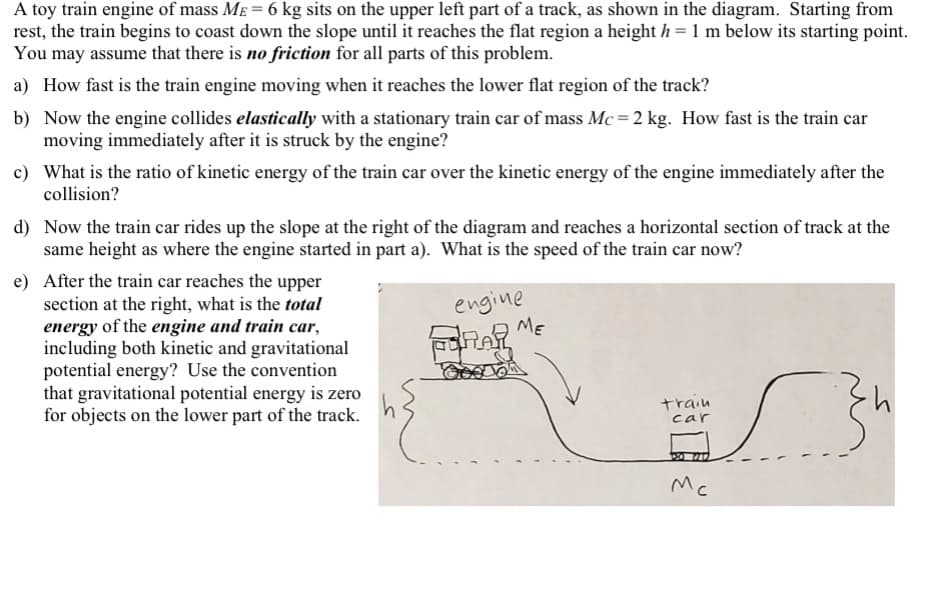A toy train engine of mass ME = 6 kg sits on the upper left part of a track, as shown in the diagram. Starting from rest, the train begins to coast down the slope until it reaches the flat region a height h = 1 m below its starting point. You may assume that there is no friction for all parts of this problem. a) How fast is the train engine moving when it reaches the lower flat region of the track? b) Now the engine collides elastically with a stationary train car of mass Mc =2 kg. How fast is the train car moving immediately after it is struck by the engine? c) What is the ratio of kinetic energy of the train car over the kinetic energy of the engine immediately after the collision?
A toy train engine of mass ME = 6 kg sits on the upper left part of a track, as shown in the diagram. Starting from rest, the train begins to coast down the slope until it reaches the flat region a height h = 1 m below its starting point. You may assume that there is no friction for all parts of this problem. a) How fast is the train engine moving when it reaches the lower flat region of the track? b) Now the engine collides elastically with a stationary train car of mass Mc =2 kg. How fast is the train car moving immediately after it is struck by the engine? c) What is the ratio of kinetic energy of the train car over the kinetic energy of the engine immediately after the collision?
Physics for Scientists and Engineers: Foundations and Connections
1st Edition
ISBN:9781133939146
Author:Katz, Debora M.
Publisher:Katz, Debora M.
Chapter10: Systems Of Particles And Conservation Of Momentum
Section: Chapter Questions
Problem 41PQ: There is a compressed spring between two laboratory carts of masses m1 = 105 g and m2 = 212 g....
Related questions
Question
PM4: please answer question and explain each step with reasoning

Transcribed Image Text:A toy train engine of mass ME = 6 kg sits on the upper left part of a track, as shown in the diagram. Starting from
rest, the train begins to coast down the slope until it reaches the flat region a height h = 1 m below its starting point.
You may assume that there is no friction for all parts of this problem.
a) How fast is the train engine moving when it reaches the lower flat region of the track?
b) Now the engine collides elastically with a stationary train car of mass Mc = 2 kg. How fast is the train car
moving immediately after it is struck by the engine?
c) What is the ratio of kinetic energy of the train car over the kinetic energy of the engine immediately after the
collision?
d) Now the train car rides up the slope at the right of the diagram and reaches a horizontal section of track at the
same height as where the engine started in part a). What is the speed of the train car now?
e) After the train car reaches the upper
section at the right, what is the total
energy of the engine and train car,
including both kinetic and gravitational
potential energy? Use the convention
that gravitational potential energy is zero
for objects on the lower part of the track.
engine
ME
train
car
Mc
Expert Solution
This question has been solved!
Explore an expertly crafted, step-by-step solution for a thorough understanding of key concepts.
Step by step
Solved in 2 steps with 1 images

Knowledge Booster
Learn more about
Need a deep-dive on the concept behind this application? Look no further. Learn more about this topic, physics and related others by exploring similar questions and additional content below.Recommended textbooks for you

Physics for Scientists and Engineers: Foundations…
Physics
ISBN:
9781133939146
Author:
Katz, Debora M.
Publisher:
Cengage Learning

Principles of Physics: A Calculus-Based Text
Physics
ISBN:
9781133104261
Author:
Raymond A. Serway, John W. Jewett
Publisher:
Cengage Learning

Physics for Scientists and Engineers, Technology …
Physics
ISBN:
9781305116399
Author:
Raymond A. Serway, John W. Jewett
Publisher:
Cengage Learning

Physics for Scientists and Engineers: Foundations…
Physics
ISBN:
9781133939146
Author:
Katz, Debora M.
Publisher:
Cengage Learning

Principles of Physics: A Calculus-Based Text
Physics
ISBN:
9781133104261
Author:
Raymond A. Serway, John W. Jewett
Publisher:
Cengage Learning

Physics for Scientists and Engineers, Technology …
Physics
ISBN:
9781305116399
Author:
Raymond A. Serway, John W. Jewett
Publisher:
Cengage Learning